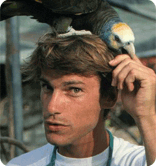Natural diet for a wild caught Grey

Dear Jamie, I am the proud owner of Marcootje, an African Grey parrot. Marcootje was caught in the wild about 50 years ago. Since then he spent his life in a cage fed with seeds and without any toys since he always wrecked his toys. When i first saw him i was not surprised he picked his feathers quite badly. When he came to live with me his life changed. I taught him how to play and wreck stuff again (starting my wallpaper I’m afraid) changed his diet to biological pellets, clipped his wings and i take him outside every day to the park or beach or woods to enjoy a bit of the wildlife he was used to. I know that clipping his wings is not ideal, but it’s better then always being inside. He loves the sun on his head and wind in his feathers.
As a conservationist you might wonder what i need to know from you when it comes to a parrot in captivity. Well, ever since I’ve had him I’ve always wanted to give him back as much Africa as i can. Therefore i want to feed him stuff he was used to when he was still living there. But on internet i can’t find the names of the plants and fruits they feed on in Africa. Even my teacher ecology who lives part time in Botswana couldn’t help me out. Off course it would be handy if i will be able to get those products in Holland.
Kind regards,
Mieke Boender

Dear Meike, First I have to say that I’m quite impressed that you have a wild caught Grey Parrot that may be as old as fifty years, that’s quite remarkable in its own right. If that history is well documented, please let us know as that could be one of the longest lived Grey Parrots with a documented past.
Second, it’s great that you’ve solved many of the problems Marcootje had when you first got him. Feather plucking can be especially difficult to resolve in any bird as has been discussed here and in the PsittaScene many times.
Third, I think you’re heart is in the right place to try to find foods which are similar to what Marcootje at in the wild. That said, there are two reasons to be cautious here. On the one hand, your bird has been away from such foods for decades and so something which might be quite edible to a wild grey in Cameroon, might be quite dangerous for your bird to eat. On the other hand, I think it’s quite unlikely that any of the really wild foods from the range of the African Grey are likely to be available in Europe. Some of these might be present in special indoor gardens, but I doubt these folks would take too kindly to your harvesting of their delicate tropical fruits, flowers, and the like!
The good news is that if your Marcootje likes destroying things, then providing him with fresh browse from trees and shrubs native to your area is likely to be something which will turn into both a fun and healthy activity for him over time. Of course, consult with other parrot keepers about the plants you have in mind to ensure that they are not dangerous for your bird, and introduce things slowly and in a supervised manner. I also recommend going to our forums and typing browse in the search box for additional discussions of this kind.
In any event, do bear in mind that if your parrot has lived for five decades and is still going strong, you’re certainly doing something right!
All best wishes,
Jamie

































